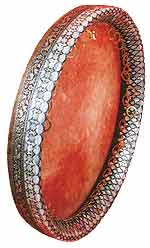 |
Qaval,
decorated with mother-of pearls
by
B.Balabeyov.
Baku. 2001 |
The
gaval belongs to the group of unilateral percussion
instruments (photo 7). There is a lot of information
about this instrument found in the works of medieval
poets. Images of gavals are presented in ancient miniatures,
showing that this instrument was widespread in Azerbaijan
during the Middle Ages. Most likely, it is the only
instrument that has preserved its original shape.
It has never been neglected. The gaval was mainly
used in palace musical majlises during the Middle
Ages.
There are varying sizes of gavals found in Eastern
countries and Central Asia. Even though the gaval
is considered to be a membranophone instrument, it
has some of the features of an idiophone instrument.
Metal rings, or sometimes a set of four small jingles,
hang from the body, producing a unique sound when
the instrument is shaken.
The
gaval was included as a lead instrument in the Traditional
Instruments Orchestra founded by Azerbaijani composer
Uzeyir Hajibeyov, who also wrote the first musical
scores for this instrument. Nowadays, the gaval plays
a significant role in ensembles and orchestras composed
of traditional instruments. This instrument has wide
performance capabilities because it is possible for
it to produce trills, tremolos, mordents and other
musical features.
The
gaval is always part of a mugham trio (musical group
consisting of a singer, tar player and kamancha player)
that performs genres and forms of traditional Azerbaijani
music such as "rangs", "derameds",
"tasnifs" and "zarbi-mughams".
The gaval's cylindrical frame is 60-75 mm tall, and
its diameter is 340-450 mm. It is made of walnut wood,
with 60-70 small copper rings fitted to the inner
side of its frame along the perimeter. Sturgeon skin
that has been tanned in a special way is stretched
over the round frame. The thinness and transparency
of the fish skin makes the sound of the instrument
especially pleasant. While playing on the instrument,
the performer holds it with his hands and plays with
his fingers. Sometimes the gaval is slapped as well.
|